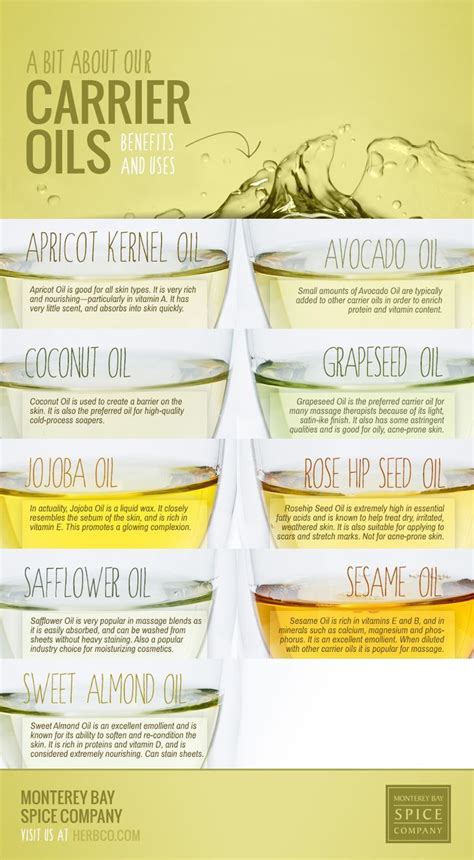Introduction

Essential oils, extracted from plants, offer a wide range of therapeutic benefits. To effectively harness their potency, carriers are essential. These substances effectively dilute essential oils, allowing for safe topical application or inhalation. This comprehensive guide delves into the world of essential oil carriers, exploring their types, benefits, and considerations.
Types of Essential Oil Carriers
Carriers vary in viscosity, absorption rate, and suitability for different purposes. Here are the main types:
- Fixed Oils (Base Oils): Oils extracted from nuts, seeds, or kernels. Examples include almond oil, coconut oil, and jojoba oil.
- Alcohol (Ethyl Alcohol): Used for creating perfumes and body sprays due to its quick evaporation rate.
- Hydrolats (Floral Waters): Aromatic waters produced during the distillation process, such as rosewater and lavender water.
- Emollients: Substances that soften and smooth skin, such as shea butter and cocoa butter.
- Surfactants: Compounds that help essential oils disperse in water, such as polysorbates and emulsifiers.
Benefits of Using Essential Oil Carriers
- Dilution: Carriers safely dilute essential oils, preventing skin irritation or allergic reactions.
- Increased Absorption: Some carriers enhance the absorption of essential oils through the skin into the bloodstream.
- Extended Aroma: Carriers prolong the aromatic qualities of essential oils, providing lasting benefits.
- Hydration: Base oils nourish and moisturize the skin, making them suitable for topical applications.
- Improved Diffusion: Carriers aid in dispersing essential oils for aromatherapy purposes, creating a therapeutic atmosphere.
Considerations for Choosing a Carrier
- Skin Type: Consider your skin’s sensitivity and oiliness when selecting a carrier.
- Purpose of Use: Determine the intended application (e.g., massage, inhalation, skincare) to select the most appropriate carrier.
- Viscosity: Opt for less viscous carriers for faster absorption and more viscous carriers for longer-lasting effects.
- Aroma: Choose a carrier that complements or enhances the aroma of the essential oil being used.
- Safety Precautions: Some carriers may interact with certain essential oils or conditions. Always consult a qualified healthcare professional before using essential oils topically.
Table 1: Types of Essential Oil Carriers
| Type | Viscosity | Absorption Rate | Suitability |
|---|---|---|---|
| Fixed Oils | Medium to high | Slow to medium | Topical applications, massage |
| Alcohol | Low | Fast | Perfumes, body sprays |
| Hydrolats | Low | Medium | Facial toners, hair rinses |
| Emollients | High | Slow | Skincare, lip balms |
| Surfactants | Low | Fast | Diffusers, cleaning agents |
Table 2: Benefits of Using Essential Oil Carriers
| Benefit | Details |
|---|---|
| Dilution | Safe use of essential oils on skin |
| Increased Absorption | Enhanced therapeutic effects |
| Extended Aroma | Prolonged benefits and ambiance |
| Hydration | Nourishment and moisturization |
| Improved Diffusion | Optimal aromatherapy experience |
Table 3: Considerations for Choosing a Carrier
| Factor | Details |
|---|---|
| Skin Type | Sensitive, oily, dry |
| Purpose of Use | Massage, inhalation, skincare |
| Viscosity | Absorption rate, duration of effects |
| Aroma | Complementary or enhancing |
| Safety Precautions | Consult a healthcare professional |
Table 4: Essential Oil Carrier Applications
| Application | Carrier Types | Examples |
|---|---|---|
| Massage | Fixed Oils, Emollients | Almond oil, coconut oil, shea butter |
| Inhalation | Hydrolats, Alcohol | Rosewater, lavender water, ethyl alcohol |
| Skincare | Fixed Oils, Emollients | Jojoba oil, argan oil, cocoa butter |
| Haircare | Fixed Oils, Hydrolats | Argan oil, coconut oil, chamomile water |
| Cleaning | Surfactants | Polysorbates, emulsifiers |
New Applications for Essential Oils
The versatility of essential oils and carriers has inspired innovative applications:
- Diffuser Blends: Create custom blends of essential oils and carriers to enhance mood, reduce stress, or purify the air.
- Essential Oil Jewelry: Diffuse essential oils using porous materials (e.g., lava beads) attached to jewelry.
- Massage Roller Balls: Dilute essential oils in a carrier and store them in roller bottles for convenient topical application.
- Bath Salts: Add essential oils and carriers to bath salts for a relaxing and therapeutic bathing experience.
- Aromatherapy Sprays: Combine essential oils and carriers in a spray bottle to create room fresheners or linens.
Conclusion
Essential oil carriers play a vital role in harnessing the therapeutic benefits of essential oils safely and effectively. By understanding the types, benefits, and considerations involved in selecting a carrier, individuals can maximize the potential of these natural remedies. Whether for aromatherapy, topical applications, or innovative uses, essential oil carriers empower users to explore the vast world of plant-based healing and well-being.
